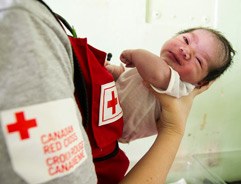 Note: The following appeal is now closed. You can support our ongoing work by donating to the Canadian Red Cross.
Note: The following appeal is now closed. You can support our ongoing work by donating to the Canadian Red Cross.
Through the generous support of Canadians, as well as corporate and government donations, over $47 million was raised to support this operation.
The Disaster
One of the strongest typhoons ever to make landfall, Typhoon Haiyan left a catastrophic impact on the Philippines when it struck on November 8, 2013. Lives were lost, homes were flattened, and communities were torn apart. Countless people saw their crops, livestock, and belongings washed away.
Red Cross Response
With generous donations from individuals, businesses and governments, the Canadian Red Cross supported emergency and recovery operations as well as disaster preparedness projects.
Emergency Relief
Responding to critical needs on the ground, the Canadian Red Cross contributed funds and supplies to the Red Cross Movement’s emergency relief operation. Reaching the most impacted areas across the Philippines, the operation assisted more than 1.3 million people in the immediate aftermath.
- 17.6 million litres of clean water distributed
- 388,000 households provided with food assistance
- 170,900 households provided with relief items (tarpaulins, hygiene kits, jerry cans, etc.)
- 91,200 households provided emergency cash grants
Lifesaving Medical Assistance
With many hospitals destroyed or badly damaged in the typhoon, the Canadian Red Cross rapidly deployed its field hospital team and equipment to the town of Ormoc on the hard-hit island of Leyte. Working in partnership with the Philippines Red Cross and the local health network, Canadian Red Cross aid workers provided essential health services, including surgical, pharmacy, maternity care and psychosocial support.
During the four-month mission, the field hospital team treated 1,226 patients, performed 114 surgeries and safely delivered 418 babies. The field hospital was handed over to the Philippine Red Cross, providing the capacity to deliver basic health care to a community of 30,000 people in the event of a future emergency. Training and supplies were also provided to the Philippines Red Cross to ensure the field hospital is ready to deploy locally. So far, the field hospital has been deployed 9 times in response to dengue outbreaks, a typhoon, and most recently to the conflict in Marawi, in the south of the country, to provide essential medical care to those fleeing the fighting.
Recovery
The Red Cross Movement shifted its operation towards helping communities and families recover from the devastation. Working with Red Cross partners on the ground, the Canadian Red Cross supported recovery projects in the provinces of Leyte, Cebu and Aklan. These efforts have contributed to the overall achievements of the Red Cross Movement:
- 75,900 houses built or repaired with Red Cross help
- 70 health facilities repaired and resupplied with medications and equipment
- 63,000 households supported with cash grants to rebuild livelihoods
- 1,490 water systems repaired or constructed
- 150 communities supported through funds for income generation projects in fishing, farming and agriculture
Disaster Preparedness & Community Resilience
In a country that is highly prone to typhoons, floods and landslides, local capacity to prepare for and respond to disaster is crucial to saving lives and protecting communities. The Canadian Red Cross is working in partnership with the Philippines Red Cross to reduce health and disaster risks within 30 communities on Panay island. The five-year project will:
- strengthen the capacity of local Red Cross chapters and enhance their ability to engage communities
- build local awareness in Health and Disaster Risk Reduction
- and collaborate with local actors to work towards establishing healthy communities that are resilient to disasters.
Red Cross Action Teams
The Canadian Red Cross has been supporting the Philippine Red Cross over the past three years enhance its capacity to respond to disasters through training local volunteers in priority chapters, organized into Red Cross Action Teams. The teams are built around a core of volunteers who specialize in the different services provided during emergency response. More than 703 volunteers have been recruited and trained over the course of the three-year project.
Donor Updates
Updated: Nov 2018